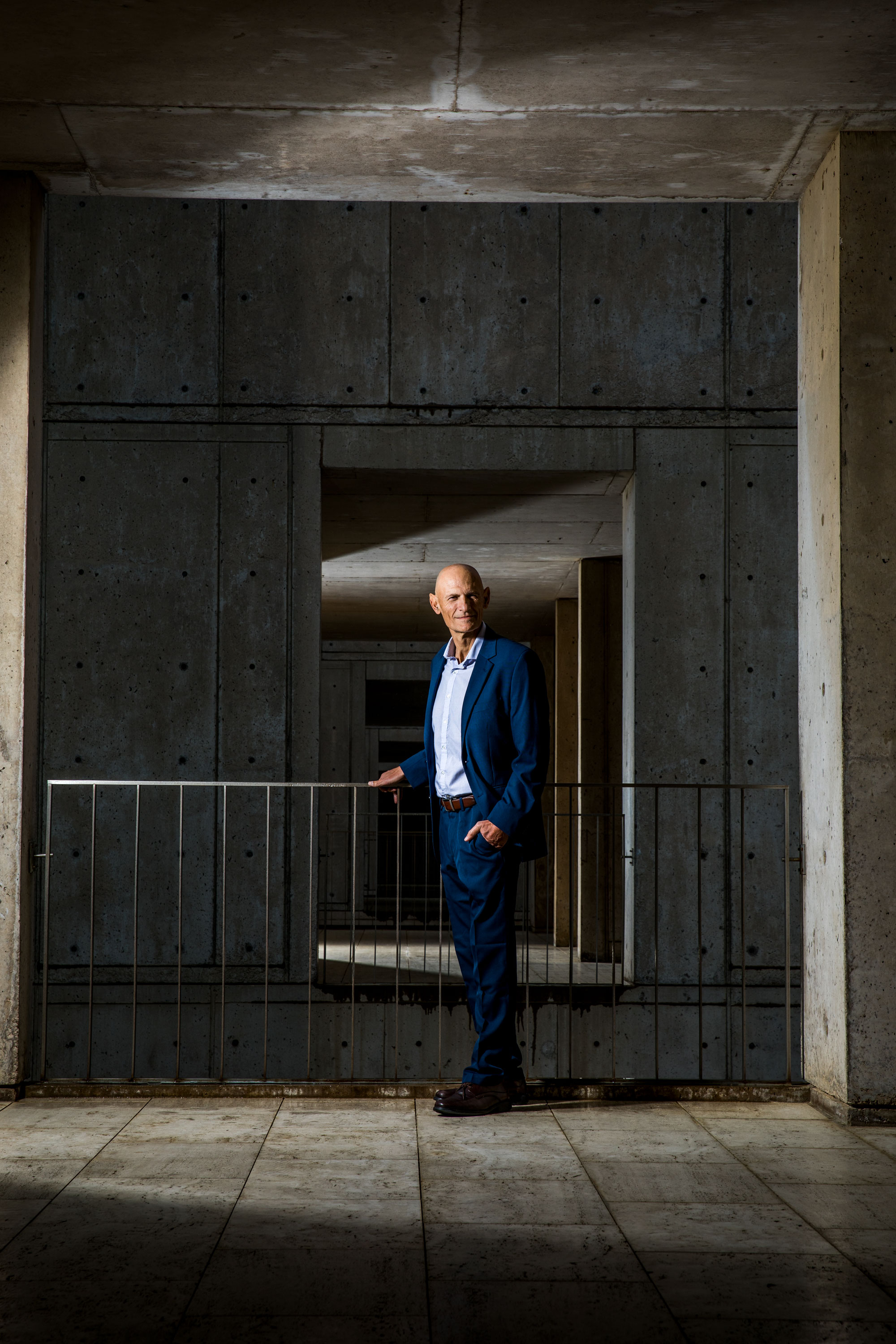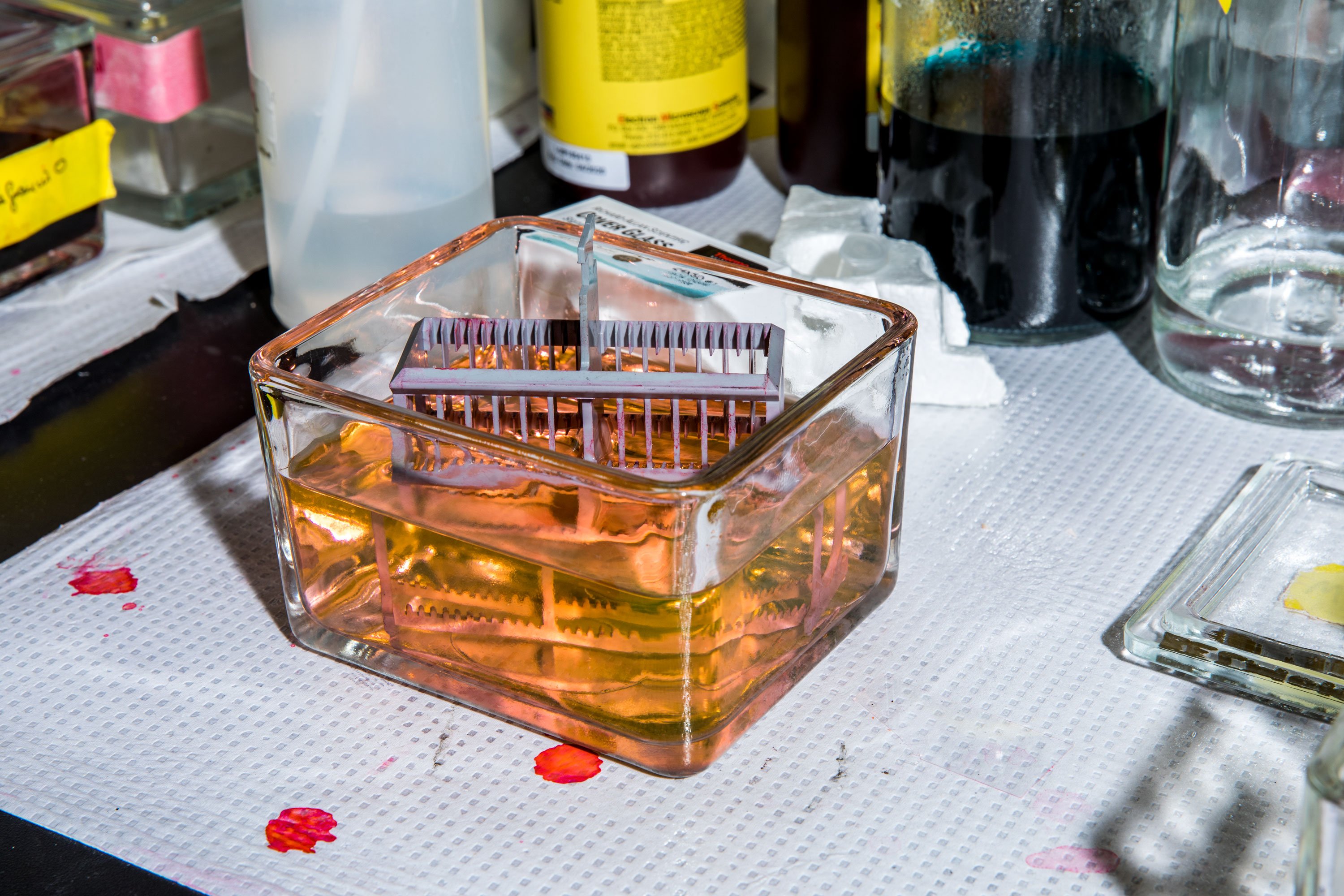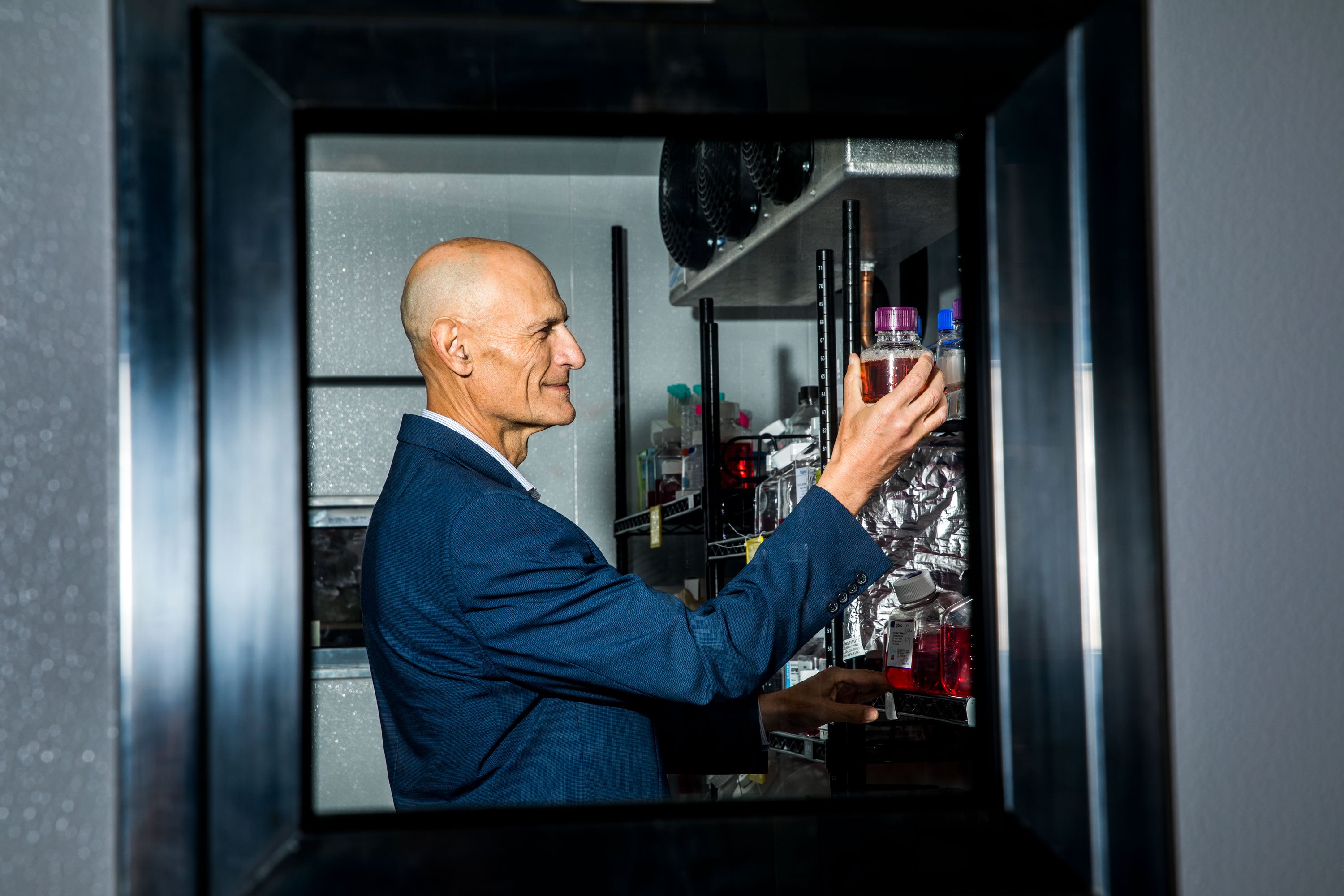S O U R C E : Technology Review

Juan Carlos Izpisúa Belmonte of the Gene Expression Laboratory at San Diego’s Salk Institute for Biological Studies
Editing the epigenome, which turns our genes on and off, could be the “elixir of life.”
The black mouse on the screen sprawls on its belly, back hunched, blinking but otherwise motionless. Its organs are failing. It appears to be days away from death. It has progeria, a disease of accelerated aging, caused by a genetic mutation. It is only three months old.
I am in the laboratory of Juan Carlos Izpisúa Belmonte, a Spaniard who works at the Gene Expression Laboratory at San Diego’s Salk Institute for Biological Studies, and who next shows me something hard to believe. It’s the same mouse, lively and active, after being treated with an age-reversal mixture. “It completely rejuvenates,” Izpisúa Belmonte tells me with a mischievous grin. “If you look inside, obviously, all the organs, all the cells are younger.”
Izpisúa Belmonte, a shrewd and soft-spoken scientist, has access to an inconceivable power. These mice, it seems, have sipped from a fountain of youth. Izpisúa Belmonte can rejuvenate aging, dying animals. He can rewind time. But just as quickly as he blows my mind, he puts a damper on the excitement. So potent was the rejuvenating treatment used on the mice that they either died after three or four days from cell malfunction or developed tumors that killed them later. An overdose of youth, you could call it.
The powerful tool that the researchers applied to the mouse is called “reprogramming.” It’s a way to reset the body’s so-called epigenetic marks: chemical switches in a cell that determine which of its genes are turned on and which are off. Erase these marks and a cell can forget if it was ever a skin or a bone cell, and revert to a much more primitive, embryonic state. The technique is frequently used by laboratories to manufacture stem cells. But Izpisúa Belmonte is in a vanguard of scientists who want to apply reprogramming to whole animals and, if they can control it precisely, to human bodies.
Izpisúa Belmonte believes epigenetic reprogramming may prove to be an “elixir of life” that will extend human life span significantly. Life expectancy has increased more than twofold in the developed world over the past two centuries. Thanks to childhood vaccines, seat belts, and so on, more people than ever reach natural old age. But there is a limit to how long anyone lives, which Izpisúa Belmonte says is because our bodies wear down through inevitable decay and deterioration. “Aging,” he writes, “is nothing other than molecular aberrations that occur at the cellular level.” It is, he says, a war with entropy that no individual has ever won.
“I think the kid that will be living to 130 is already with us. He has already been born. I’m convinced.”
But each generation brings new possibilities, as the epigenome gets reset during reproduction when a new embryo is formed. Cloning takes advantage of reprogramming, too: a calf cloned from an adult bull contains the same DNA as the parent, just refreshed. In both cases, the offspring is born without the accumulated “aberrations” that Izpisúa Belmonte refers to.
What Izpisúa Belmonte is proposing is to go one step better still, and reverse aging-related aberrations without having to create a new individual. Among these are changes to our epigenetic marks—chemical groups called histones and methylation marks, which wrap around a cell’s DNA and function as on/off switches for genes. The accumulation of these changes causes the cells to function less efficiently as we get older, and some scientists, Izpisúa Belmonte included, think they could be part of why we age in the first place. If so, then reversing these epigenetic changes through reprogramming may enable us to turn back aging itself.
Izpisúa Belmonte cautions that epigenetic tweaks won’t “make you live forever,” but they might delay your expiration date. As he sees it, there is no reason to think we cannot extend human life span by another 30 to 50 years, at least. “I think the kid that will be living to 130 is already with us,” Izpisúa Belmonte says. “He has already been born. I’m convinced.”

A jar with a staining solution used to study tissues.
The treatment Izpisúa Belmonte gave his mice is based on a Nobel-winning discovery by the Japanese stem-cell scientist Shinya Yamanaka. Starting in 2006, Yamanaka demonstrated how adding just four proteins to human adult cells could reprogram them so that they look and act like those in a newly formed embryo. These proteins, called the Yamanaka factors, function by wiping clean the epigenetic marks in a cell, giving it a fresh start.
“He went backwards in time,” Izpisúa Belmonte says. All the methylation marks, those epigenetic switches, “are erased,” he adds. “Then you’re starting life again.” Even skin cells from centenarians, scientists have found, can be rewound to a primitive, youthful state. The artificially reprogrammed cells are called induced pluripotent stem cells, or IPSCs. Like the stem cells in embryos, they can then turn into any kind of body cell—skin, bone, muscle, and so on—if given the right chemical signals.
To many scientists, Yamanaka’s discovery was promising mainly as a way to manufacture replacement tissue for use in new types of transplant treatments. In Japan, researchers began an effort to reprogram cells from a Japanese woman in her 80s with a blinding disease, macular degeneration. They were able to take a sample of her cells, return them to an embryonic state with Yamanaka’s factors, and then direct them to become retinal cells. In 2014, the woman became the first person to receive a transplant of such lab-made tissue. It didn’t make her vision sharper, but she did report it as being “brighter,” and it stopped deteriorating.
Before then, though, researchers at the Spanish National Cancer Research Centre had already taken the technology in a new direction when they studied mice whose genomes harbored extra copies of the Yamanaka factors. Turning these on, they demonstrated that cell reprogramming could actually occur inside an adult animal body, not only in a laboratory dish.
The experiment suggested an entirely new form of medicine. You could potentially rejuvenate a person’s entire body. But it also underscored the dangers. Clear away too many of the methylation marks and other footprints of the epigenome and “your cells basically lose their identity,” says Pradeep Reddy, a staff researcher at Salk who worked on these experiments with Izpisúa Belmonte. “You are erasing their memory.” These cellular blank slates can grow into a mature, functioning cell, or into one that never develops the ability to perform its designated task. It can also become a cancer cell.
That’s why the mice I saw in Izpisúa Belmonte’s lab were prone to sprouting tumors. It proved that cellular reprogramming had indeed occurred inside their bodies, but the results were usually fatal.
Izpisúa Belmonte believed there might be a way to give mice a less lethal dose of reprogramming. He was inspired by salamanders, which can regrow an arm or tail. Researchers have yet to determine exactly how amphibians do this, but one theory is that it happens through a process of epigenetic resetting similar to what the Yamanaka factors achieve, though more limited in scope. With salamanders, their cells “just go back a little bit” in time, Izpisúa Belmonte says.
Could the same thing be done to an entire animal? Could it be rejuvenated just enough?
In 2016, the team devised a way to partially rewind the cells in mice with progeria. They genetically modified the mice to produce the Yamanaka factors in their bodies, just as the Spanish researchers had done; but this time, the mice would produce those factors only when given an antibiotic, doxycycline.
In Izpisúa Belmonte’s lab, some mice were allowed to drink water containing doxycycline continuously. In another experiment, others got it just for two days out of every seven. “When you give them … doxycycline, expression of the genes starts,” explains Reddy. “The moment you remove it, the expression of the genes stops. You can easily turn it on or off.”
The mice that drank the most, like the one Izpisúa Belmonte showed me, quickly died. But the mice that drank a limited dose did not develop tumors. Instead, they became more physically robust, their kidneys and spleens worked better, and their hearts pumped harder.
In all, the treated mice also lived 30% longer than their littermates. “That was the benefit,” Izpisúa Belmonte says. “We don’t kill the mouse. We don’t generate tumors, but we have our rejuvenation.”

Izpisúa Belmonte at work.
When Izpisúa Belmonte published his report in the journal Cell, describing the rejuvenated mice, it seemed to some as if Ponce de Leon had finally spotted the fountain of youth. “I think Izpisúa Belmonte’s paper woke a lot of people up,” says Michael West, CEO of AgeX, which is pursing similar aging reversal technology. “All of a sudden all of the leaders in aging research are like, ‘Oh, my gosh, this could work in the human body.’”
To West, the technology offers the prospect that humans, like salamanders, could regenerate tissues or damaged organs. “Humans have that ability too, when we are first forming,” he says. “So if we can reawaken those pathways ... wow!”
To others, however, the evidence for rejuvenation is plainly in its infancy. Jan Vijg, chair of the genetics department at the Albert Einstein College of Medicine in New York City, says aging consists of “hundreds of different processes” to which simple solutions are unlikely. Theoretically, he believes, science can “create processes that are so powerful they could override all of the other ones.” But he adds, “We don’t know that right now.”
An even broader doubt is whether the epigenetic changes that Izpisúa Belmonte is reversing in his lab are really the cause of aging or just a sign of it—the equivalent of wrinkles in aging skin. If so, Izpisúa Belmonte’s treatment might be like smoothing out wrinkles, a purely cosmetic effect. “We have no way of knowing, and there is really no evidence, that says the DNA methylation [is] causing these cells to age,” says John Greally, another professor at Einstein. The notion that “if I change those DNA methylations, I will be influencing aging,” he says, “has red flags all over it.”
One other fundamental question hangs over Izpisúa Belmonte’s findings: while he succeeded in rejuvenating mice with progeria, he hasn’t done it in normal aged animals. Progeria is an illness due to a single DNA mutation. Natural aging is much more complex, says Vittorio Sebastiano, an assistant professor at the Stanford Institute for Stem Cell Biology and Regenerative Medicine. Would the rejuvenation technique work in naturally aged animals and in human cells? He says Izpisúa Belmonte’s research so far leaves that crucial question unanswered.
Izpisúa Belmonte’s team is working to answer it. Experiments to rejuvenate normal mice are under way. But because normal mice live as long as two and a half years, whereas those with progeria live three months, the evidence is taking longer to gather. “And if we have to modify any experimental condition,” Reddy says, “then the whole cycle will have to be repeated.”
Editing age
Wholesale rejuvenation, then, is still far off, if it will ever come at all. But more limited versions of it, targeted to certain diseases of aging, might be available within a few years.
If the Yamanaka factors are like a scattergun that wipes out all the epigenetic marks associated with aging, the techniques now being developed at Salk and in other labs are more like sniper rifles. The goal is to allow researchers to switch off a specific gene that causes a disease, or switch on another gene that can alleviate it.
Hsin-Kai Liao and Fumiyuki Hatanaka spent four years in Izpisúa Belmonte’s lab adapting CRISPR-Cas9, the famed DNA “editing” system, to instead act as a volume control knob. Whereas the original CRISPR lets researchers eliminate an unwanted gene, the adapted tool allows them to leave the genetic code untouched but determine whether a gene is turned on or off.
The lab has tested this tool on mice with muscular dystrophy, which lack a gene that’s crucial in maintaining muscle. Using the epigenome editor, the researchers cranked up the output of another gene that can play a substitute role. The mice they treated did better on grip tests, and their muscles “had become much larger,” Liao remembers.
Another result of this kind came from beyond the Salk campus, at the University of California, Irvine. Researcher Marcelo Wood claims that activating a single gene in old mice improves their memory in a test involving moving objects. “We restored long-term memory function in those animals,” says Wood, who published the results in Nature Communications. After a single epigenetic block is removed, says Wood, “the genes for memory—they all fire. Now that animal perfectly encodes that information straight into long-term memory.”
“I think turning back the clock is an appropriate way to explain it.”
Similarly, researchers at Duke University have developed an epigenetic editing technique (not yet tested on animals) to turn down the volume on a gene implicated in Parkinson’s disease. Another Duke team brought down the levels of cholesterol in mice by turning off a gene that regulates it. Izpisúa Belmonte’s lab itself, as well as experimenting with muscular dystrophy, has worked on rolling back the symptoms of diabetes, kidney disease, and the loss of bone cartilage, all using similar methods.
The first human tests of these techniques are likely to happen in the next few years. Two companies pursuing the technology are AgeX and Turn Biotechnologies, a startup cofounded by Sebastiano from Stanford. AgeX, says West, its CEO, is looking to target heart tissues, while Turn, according to Sebastiano, will begin by seeking regulatory clearance to test treatments for osteoarthritis and aging-related muscle loss.
Meanwhile GenuCure, a biotech company founded by Ilir Dubova, a former researcher at Salk, is raising funds to pursue an idea for rejuvenating cartilage. The company has a “cocktail,” Dubova says, that will be injected into the knee capsule of people with osteoarthritis, perhaps once or twice a year. Such a treatment could take the place of expensive knee replacement surgeries.
“After injection, these … genes that were silenced due to aging would be turned on, thanks to our witchcraft, and start the rejuvenation process of the tissue,” Dubova says. “I think turning back the clock is an appropriate way to explain it.”
.











































